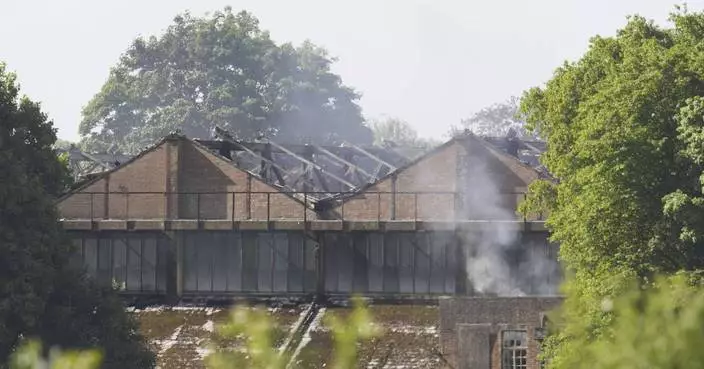A million-dollar question: Is a billionaire with negative equity richer than a middle-class individual with over ten million net assets? I would say that a bankrupt tycoon is poorer than both, even compared to a grassroots citizen with just $100 in savings and no debt. This "tycoon" on the brink of bankruptcy is the United States.
On April 15, amid the escalating tariff war, White House Spokesperson Leavitt read a statement from U.S. President Donald Trump: “China wants what we have. Every country wants what we have—American consumers, or in other words, they need our money.”
But the real question is: Does America have money? No—it has only debt. According to the U.S. National Debt Clock, the federal debt has ballooned to $36.8 trillion, nearing $37 trillion. In 2008, U.S. debt stood at $10 trillion. Over 17 years, it surged by nearly $27 trillion—a terrifying trajectory.
Trump recently backtracked, claiming he would soon slash tariffs on China. The U.S.-China tariff standoff resembles the game of chicken: two cars speeding toward each other, with the first to swerve labeled the coward. Trump, now the one blinking, fears something deeper. Critics speculate his fears include soaring prices that angers U.S. consumers; China’s halt on purchase of U.S. liquefied natural gas in April, leaving surplus gas no place to store; and farmers finding him responsible when no one buys their soybeans. Others cite the stock market plunge also unsettles him.
Yet Trump’s true fear lies in an impending bond market crash. If U.S. Treasury prices collapse, stocks and the dollar will follow, triggering a meltdown rivalling the 2008 financial crisis. Recent single-day bond price crashes—akin to a canary dying in a coal mine—signal looming disaster.
The debt crisis has a deadline. This year, $8.5 trillion in U.S. Treasuries will mature, with $5.8 trillion due in June alone, equivalent to 22% of 2024 U.S. GDP. Most June maturities are 5-year bonds issued at 1.8% interest during COVID-19 as relief efforts. The interest rate has much soared since then.
The bigger problem is weak market demand. Poor Treasury auction performances compound the problem. Usually the Federal Reserve will buy up when the market is weak. But, instead of buying, the Feb plans to shrink its balance sheet by $1.2 trillion this year. Even if all $8.5 trillion in new debt is sold, higher rates in the range of 4.5% will drastically increase fiscal burdens.
The immediate threat is June’s debt rollover. With the tariff war ongoing and Trump threatening to fire Fed Chair Jerome Powell, the Treasury market resembles a powder keg. If Trump fails to resolve the tariff dispute by May, June’s debt tsunami could detonate the market.
In this fragile environment, a 15-minute bond sell-off could trigger mass liquidations. Hedge funds leveraged in Treasury arbitrage (holding ~$1 trillion in positions) would face cascading losses. A single actor could ignite this bomb, or Japan’s central bank might sell U.S. Treasuries to support its own bonds, sparking chaos indirectly.
Trump’s tariff war lacks preparation, strategy, and economic logic. A debt-ridden nation antagonizing its creditors is absurd. We can sit back, grab some popcorn and watch Trump struggle to defuse his self-made debt crisis.
Wing-hung Lo
Bastille Commentary
** The blog article is the sole responsibility of the author and does not represent the position of our company. **
When a nation openly seeks to recruit spies to steal another country’s secrets, the target state cannot afford to look away. In the latest episode of this ongoing contest, the United States has taken center stage.
On May 1, the Central Intelligence Agency (CIA) of the United States released two new videos, publicly appealing to Chinese citizens to collaborate with the agency and engage in espionage against their own government. The videos mark a strikingly public approach to intelligence recruitment – a move that doubles as psychological warfare.
Last year, the CIA had already published an instructional video in Chinese, teaching Chinese nationals how to use the dark web to contact the agency securely. An anonymous US official puts it, as quoted by The New York Times, the CIA would not have produced the latest videos if the earlier attempt had not yielded results.
John Ratcliffe, newly appointed as CIA director by Donald Trump, has made clear that China is now the agency’s top priority. In a message to CIA personnel last month, Ratcliffe underscored the urgency of rebuilding the agency’s human intelligence network in China, emphasizing the need to recruit Chinese officials to obtain state secrets.
Hong Kong in the Crosshairs
It would be a mistake to assume that these developments have little bearing on Hong Kong. The city remains a focal point for US intelligence-gathering efforts against China. The Hong Kong government has been drafting supplementary regulations to implement the Hong Kong National Security Law and the Safeguarding National Security Ordinance for some time. In the face of mounting challenges from the United States and other Western powers, early enactment of such regulations is a matter of prudence.
The new subsidiary legislation under the Safeguarding National Security Ordinance recently introduced by the government include provisions allowing the Office for Safeguarding National Security of the Central People’s Government in the Hong Kong Special Administrative Region (OSNS) to designate official premises and prohibit unauthorized disclosure of the office’s investigative work.
Existing Powers Clarified
After the announcement of the new regulations, some online commentators questioned whether this signalled an expansion of the OSNS’s powers. In reality, these authorities already exist; the new rules simply clarify their scope and procedures. Article 55 of the National Security Law stipulates that the OSNS may exercise jurisdiction in serious cases, including those involving foreign interference or when the SAR faces genuine difficulties in enforcement. The office’s authority to take over such cases has always existed and has not been expanded. Given the CIA’s public campaign to recruit Chinese spies, it would be naïve to assume that such scenarios will never arise.
The subsidiary legislation also sets out operational details. Civil servants are required to provide all necessary and reasonable assistance to the OSNS in a timely manner. Any individual must comply with legal instruments issued by the OSNS under Article 57 of the National Security Law; failing to comply, providing false information, or disclosing details of OSNS investigations all constitute criminal offenses. Deliberately obstructing the OSNS, impersonating its personnel, or forging its documents are also criminal acts. These provisions mirror similar offenses in existing Hong Kong law, simply making clear that OSNS personnel receive the same legal protections as other officials when performing their duties. In short, the regulations clarify the scope of authority – not expand it.
Enhancing Protections, Not Restrictions
When the OSNS exercises its duties in Hong Kong, the relevant legal procedures, the scope of protected work, and the obligations of other government agencies to assist must all be clearly defined by subsidiary legislation. Critics often view such regulations as restrictions on the public, but this is a misreading. For example, after the regulations took effect, the SAR government designated six locations, including the Metropark Hotel Causeway Bay, as restricted zones. Some have claimed these “forbidden zones” are close to residential areas and wondered whether one could even speak to people coming out of these places, fearing they might inadvertently break the law. Such concerns are exaggerated.
Designating OSNS offices as prohibited areas is no different from the military barracks found in urban districts, which are also clearly marked as off-limits. There are schools and residential buildings near the Kowloon Tong barracks, yet daily life is unaffected. Ordinary residents do not wander into such places; clear signage simply serves as a reminder not to trespass. This does not increase the risk of legal trouble for citizens – unauthorized entry was already illegal. In fact, the new rules enhance protection by reducing the chance of accidental trespass due to ignorance. Any sensible person should understand: unless you are answering the CIA’s recruitment call, you have no business entering OSNS offices.
The new national security regulations have no impact on law-abiding citizens, but they strike directly at foreign spies. By explicitly criminalizing acts related to the OSNS’s exercise of its powers, foreign agents caught red-handed can no longer exploit legal loopholes by claiming that OSNS personnel are not protected by local law or that they can openly defy authorities.
Lo Wing-hung





















































